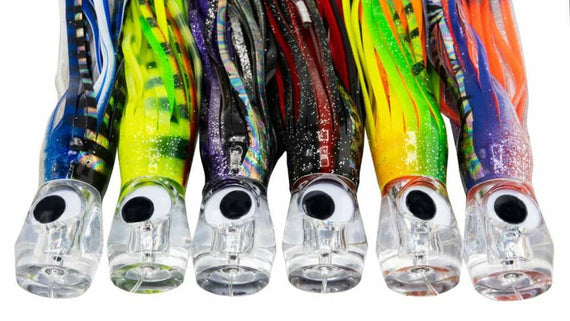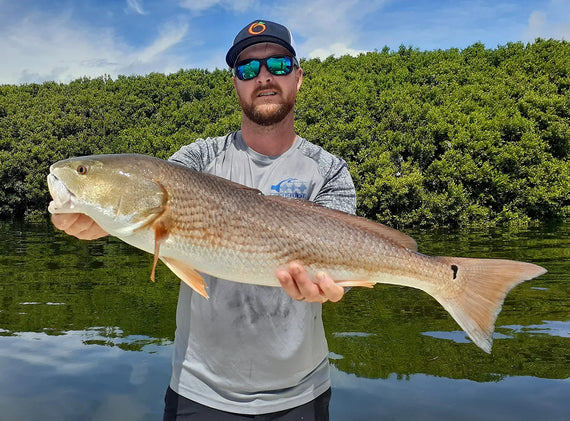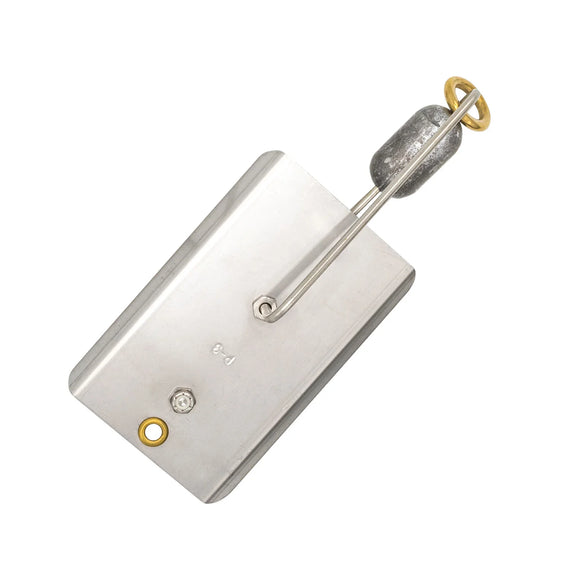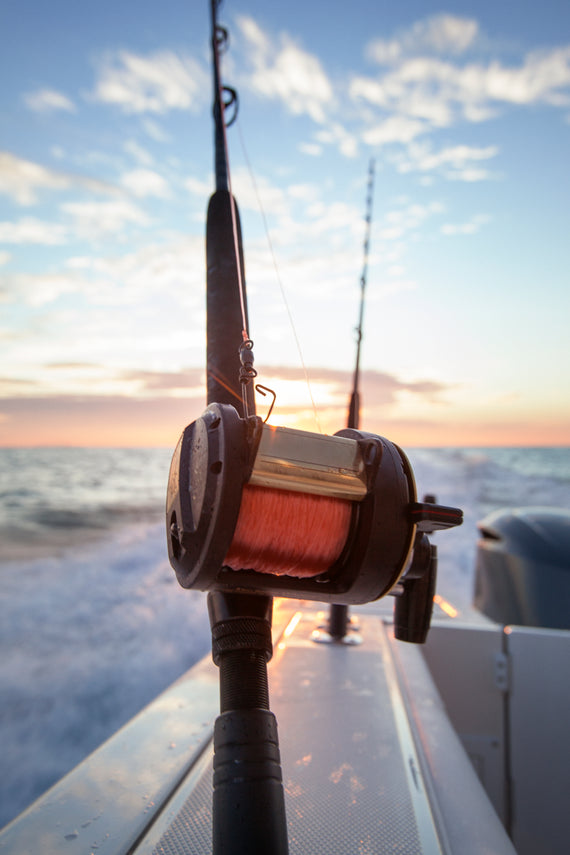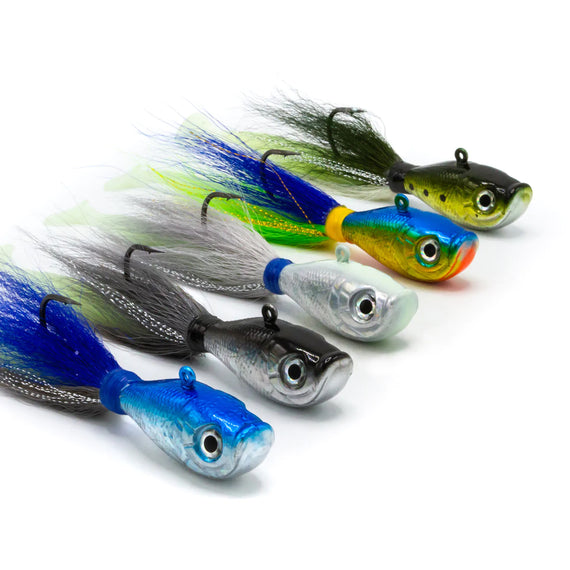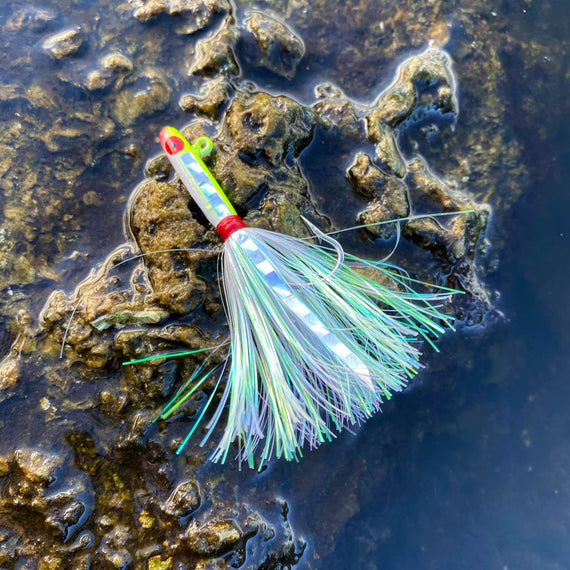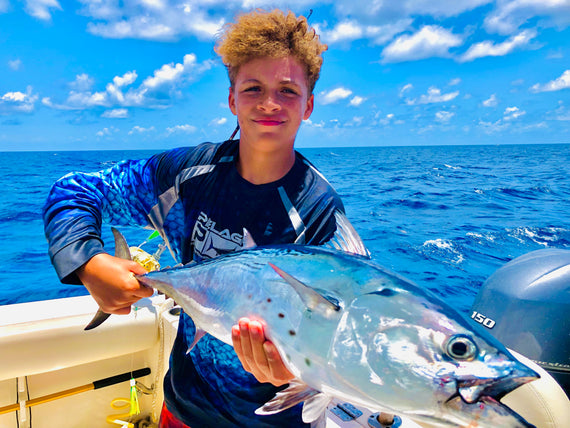-
![The 8 Essential Types of Trolling Lures: A Guide for Beginner Anglers]()
The 8 Essential Types of Trolling Lures: A Guide for Beginner Anglers
Whether you're new to trolling or looking to improve your fishing game, understanding the different types of trolling lures is essential. Saltwater trolling lures play a crucial role in attracting the right type of fish and ensuring a successful catch. With so many options, you may wonder what lures to use for trolling. Deciding which lure works best for your fishing goals, whether in freshwater or saltwater, can be overwhelming. In this guide, we’ll explore the eight basic types of trolling lures, where they’re used, what fish they attract, and how they can enhance your fishing experience. What Are Trolling Lures? Trolling lures are artificial baits designed to mimic the movement of live prey, attracting fish as you pull the lure behind a moving boat. Depending on the environment, trolling lures can be used in saltwater and freshwater settings, and they come in a wide range of designs suited to different fish species. Choosing the right trolling lure is crucial for improving your chances of success, and understanding the basics is the first step toward making the right choice. Whether you're heading out for offshore fishing in saltwater or casting in freshwater lakes, the right trolling lure will make a difference in the size and type of fish you catch. 8 Must-Have Basic Trolling Lures 1. Plunger Trolling Lures Plunger trolling lures are a go-to for many saltwater anglers targeting big-game fish like marlin and tuna. Their cylindrical shape allows them to make a big splash on the water’s surface, mimicking the movements of a distressed fish, which attracts predatory species. Where It’s Used: Primarily used in saltwater, especially offshore for large game. Fish It Attracts: Marlin, tuna, and wahoo. Benefits: Ideal for attracting large game fish in deep-sea environments. 2. Doorknob Trolling Lures Named for their unique shape, doorknob trolling lures are designed for stability in rough waters. They stay submerged while creating a noticeable trail that draws in fish from a distance. These offshore trolling lures work best in offshore settings where fish hunt in deeper waters. Where It’s Used: Best for offshore saltwater fishing. Fish It Attracts Mahi-mahi, sailfish, and kingfish. Benefits: Effective in rougher waters where other lures might struggle to maintain their path. 3. Chugger Trolling Lures Chugger trolling lures create a “chugging” effect as they move through the water, producing bubbles and noise that grab the attention of predatory fish. This type of trolling lure is perfect for anglers looking to create a disturbance on the surface to lure fish up from deeper waters. Where It’s Used: Best for saltwater and offshore fishing. Fish It Attracts: Marlin, tuna, and sailfish. Benefits: Highly visible and effective at creating surface-level disturbance. 4. Scoop Face or Slant Head Trolling Lures Scoop face or slant head trolling lures are designed to dive and dart through the water, imitating a baitfish in distress. Their angled heads give them a distinct swimming motion that attracts fish, making them perfect for trolling at a range of speeds. Where It’s Used: Suitable for both saltwater and freshwater environments. Fish It Attracts: Tuna, wahoo, kingfish, and swordfish. Benefits: Versatile and effective at different trolling speeds. 5. Dive Plug Trolling Lures Dive plug trolling lures are heavy-duty lures designed to dive deep into the water column, attracting fish below the surface. Their deep diving capabilities make them essential for fishing in deeper offshore waters where large predatory fish tend to roam. Where It’s Used: Best suited for deep offshore saltwater fishing. Fish It Attracts: Grouper, snapper, and amberjack. Benefits: Perfect for deep trolling in search of bottom-dwelling fish. 6. Soft Head Trolling Lures Soft head trolling lures have a soft plastic head that provides a realistic feel for fish when they strike. This lure mimics the natural movement of prey, making it highly effective for species wary of hard, unnatural baits. These soft baits make a great choice for freshwater or saltwater. Where It’s Used: Primarily used in saltwater, but can also be effective in freshwater. Fish It Attracts: Tuna, mackerel, and swordfish. Benefits: Offers a lifelike feel that can increase the chances of a fish striking and staying on the line. 7. Bullet Head Trolling Lures Bullet head trolling lures are designed for high-speed trolling. Their streamlined shape cuts through the water easily, making them a favorite among anglers targeting fast-moving fish like wahoo and tuna. These lures can be trolled at high speeds without losing their effectiveness. Where It’s Used: Ideal for offshore saltwater trolling at high speeds. Fish It Attracts Wahoo, tuna, and dolphin (mahi-mahi). Benefits: Great for covering large areas of water quickly while maintaining effective action. 8. Jet Head or Bubbler Trolling Lures Jet head trolling lures, or bubbler lures, create a bubble trail behind them as they move through the water. This bubbling action attracts fish by mimicking a fleeing baitfish, making it especially useful for targeting large predatory species in saltwater environments. Where It’s Used: Primarily in saltwater, especially in offshore settings. Fish It Attracts: Marlin, tuna, and wahoo. Benefits: The bubble trail creates extra visibility, attracting fish from greater distances. How to Choose the Right Trolling Lure Choosing the right trolling lure depends on the species you're targeting, water conditions, trolling speed, and whether you're fishing in saltwater, freshwater, or both. Target Species Identifying the fish you're after is crucial for choosing the right lure. Saltwater species like tuna, marlin, and wahoo respond best to lures designed for saltwater trolling, such as bullet head and plunger lures. For freshwater species like bass or pike, lures like dive plugs and scoop face lures work well due to their ability to dive deep and cover different water depths. If you’re fishing in both environments, versatile lures like the soft head can effectively attract fish in both freshwater and saltwater. Water Conditions Whether you're fishing in calm lakes or offshore seas, water conditions affect the performance of your lure. In saltwater, when the water is rough, opt for lures like the doorknob or jet head, which are designed to maintain their path and create visible, attention-grabbing trails even in challenging conditions. In calmer freshwater settings, surface lures like the chugger are effective at creating a splash that can lure fish from deeper areas to the surface. Trolling Speed Lures designed for high-speed trolling, like the bullet head, are best suited for offshore saltwater fishing, where you might be targeting fast species such as wahoo and tuna. Conversely, slower trolling speeds can be more effective in freshwater, where fish are less aggressive. For these settings, lures like dive plugs are ideal for slowly covering a range of depths while mimicking the movement of prey fish. Depth of Fishing If you're targeting deep-water species in saltwater or freshwater, you'll need lures that can dive into the lower water columns, such as dive plugs. For surface trolling, particularly in saltwater, lures like the plunger or chugger create surface-level disturbances that can attract fish like marlin and tuna. For freshwater fishing lures, the scoop face lure is versatile for fishing at different depths, depending on the speed and trolling conditions. Water Clarity and Light Conditions In clear waters (saltwater or freshwater), bright or reflective lures like plungers or jet head lures are effective at mimicking baitfish. In murky water or low-light conditions, lures that rely on vibration, motion, or bubble trails—like the chugger for saltwater or dive plugs for freshwater—are better at drawing fish in by sensory cues other than sight. Benefits of Using the Right Trolling Lure Selecting the correct trolling lure tailored to the environment—whether saltwater, freshwater, or both—provides several significant benefits, enhancing both efficiency and overall catch rate. Improved Efficiency Using the right trolling lure ensures you target the right fish in the correct environment. Saltwater fishing lures like the bullet head or jet head are built for high-speed offshore trolling, helping you cover vast open ocean areas in search of fast predators like tuna or wahoo. Meanwhile, freshwater trolling lures like dive plugs are designed to reach deeper levels in lakes and reservoirs where species like bass or trout are more commonly found. Some lures, like the soft head, can work in fresh and saltwater, offering versatility. Higher Catch Rates The right trolling lure increases your chances of success by mimicking the natural prey of your target fish. For example, plunger lures in saltwater create surface splashes that attract large predatory fish like marlin, while dive plugs in freshwater effectively reach fish residing deeper in the water. This specificity makes it easier to entice fish, leading to a higher rate of hook-ups. Versatility Across Environments Some lures, like the soft head, can be used in fresh and saltwater environments, allowing you to switch between fishing conditions without needing a completely different set of equipment. These versatile lures adapt well to different depths and species, providing a reliable option when fishing in diverse environments. Maximized Coverage In saltwater fishing, lures like the bullet head allow for high-speed trolling, which is ideal when you cover large expanses of ocean to find fish. This is useful when fish are scattered across a wide area. In freshwater, slower trolling lures like dive plugs allow you to target specific depths where fish might lurk, maximizing your coverage by reaching various water levels in lakes and reservoirs. Enhanced Attractiveness to Fish The right trolling lure is designed to appeal to fish senses beyond just sight. Saltwater lures like the chugger or jet head produce noise, bubbles, and vibration, mimicking a distressed or fleeing prey, which draws predatory fish from greater distances. For freshwater environments, dive plugs replicate the movement of prey at varying depths, increasing the lure's effectiveness by offering visual and motion cues that fish find irresistible. Stock Up on Rite AnglerTrolling Lures Choosing the right trolling lure can make a huge difference in your fishing success. Whether you're just getting started or looking to expand your knowledge of trolling lures, understanding the eight basic types will help you make more informed decisions on the water. Explore the wide selection of trolling lures at Rite Angler, and make sure you're equipped with the right tools for your next fishing adventure.Read more -
![6 Best Rigs and Baits For Catching Redfish]()
6 Best Rigs and Baits For Catching Redfish
Redfish are one of the most popular sport fish in the United States. Some might even describe them as one of the most accommodating inshore gamefish. An enthusiast can catch red drums in almost any imaginable way! Why are redfish so popular with fishermen? The reasons are simple: they strike hard when hooked, can get very big, and remain delectable when adequately prepared. Moreover, red drums don’t generally take long runs like numerous other game fish, they’re unfussy eaters but put up a great fight. Finding the perfect redfish rig, bait, or lure can be challenging, as there’s no one-size-fits-all solution. With various options out there to choose from that can fill a cooler in no time, our team from Rite Angler wants to break down some of the best redfish rigs, lures, and baits. Top Jig Rigs for Redfish The best redfish lures, baits, and rigs will depend on where and how you want to fish and the size of the redfish you’re fishing for. The best redfish rigs for pier or beach fishing may not ideally suit fishing for red drums in grass flats or other areas. That said, here are our best rigs for redfish. Most fishermen only need 2 to 3 redfish rigs for their purposes. Once you succeed with a few setups, trying out different options might help you achieve better results. Jig Rigs Jig rigs serve as one of the simplest redfish rigs for pier fishing, are incredibly versatile, and remain suitable for numerous kinds of baits and fishing techniques. However, fishermen must remember that jig heads, or any hooks for that matter, can easily become snagged in cover. Jig rigs are suitable in almost any situation where we can find redfish close to shore, making them the ideal redfish rigs for pier fishing, jetties, surf casting, or when fishing from a boat. The easiest way to set up a jig rig is by tying a jig head directly to the main line. Some fishermen may also choose to use a few feet of fluorocarbon leader as a helpful addition in clear-water conditions. Simply bait a jig head with your bait of choice and cast it out, letting it sink to the bottom. When retrieving the lure, bounce the jig rig along the bottom. This technique will help the rig perform better and attract redfish who feed on the bottom. Let’s take a look at the best jig rigs that you can use on your next fishing adventure. Soft Plastic Jigs The most common soft plastic jigs have a small “tail” that emits a scent to attract redfish. While fish like snook feed utilizing their sight, redfish typically feed by smell. You can determine the speed and action of the soft plastic jigs after determining where redfish reside in the water column. To enhance your soft plastic rig setup for redfish, consider experimenting with different jig styles and sizes. Paddle tails, for example, create more vibration in the water, mimicking the movement of baitfish, which can be particularly effective when redfish feed aggressively. Additionally, pairing your soft plastics with a weighted jighead allows you to control the lure's depth and presentation, making it easier to target fish at different levels in the water column. Remember to adjust your retrieve speed depending on the behavior of the redfish and the water conditions, ensuring your lure looks as natural as possible. Topwater Skimmer Jigs When fishing in shallower waters, flats, or clear water, topwater skimmer jigs can entice red drums to produce one of the most exciting topwater strikes a fisherman will ever experience. You can position a topwater skimmer jig anywhere in the water column, and they work well even near the bottom. With a medium sink rate, many topwater jigs provide the necessary time to present the bait properly. Topwater skimmer jigs are especially effective in the early morning or late evening when redfish are more likely to feed near the surface. Their lifelike action and splash create a disturbance that mimics a fleeing baitfish, triggering aggressive strikes from redfish patrolling shallow waters. Popping Cork Rig The popping cork is a favorite for many fishermen aiming for inshore redfish. The setup works best in cold, shallow water under 5 feet in depth. Low water temperatures make the red drums more lethargic. Popping cork redfish rigs make a chugging sound with a popping cork that stimulates and attracts redfish to the surface commotion. The “pop-pop-pop” sound simulates surface feeding or bait fleeing from predators. Game fish come to investigate the sounds or catch a scent of dangling bait enabling the fishermen to set the hook. Best Baits for Redfish Getting the redfish to bite is as much about the bait as the rig and lure. You must consider everything about the water where you fish and best redfish bait to make the ideal choice. Shrimp Live shrimp is one of the most widely available bait options for catching redfish. More importantly, redfish love the smell and taste of baited shrimp, rarely ignoring them. The secret to fishing with live shrimp is to try and keep the shrimp alive and healthy for as long as possible. A lively shrimp will keep moving in the water, helping a redfish to spot it easily. Crab Live crab is among the best baits available today for catching larger bull redfish. Larger reds will have a larger mouth, enabling them to devour an entire crab with little problem. The best way to rig a live crab is to remove a leg and place the hook through a leg hole. You should guide the hook through the crab shell, firmly setting it in place. Moreover, when fishing for smaller red drums. Top Redfish Lures When selecting the best redfish lures, a few consistently stand out due to their effectiveness. These lures are designed to mimic the natural prey of redfish, making them irresistible to these aggressive feeders and the best lures for redfish. Here are a few popular lures that can help you attract and catch redfish: Shrimp Imitations Shrimp lures are incredibly effective, especially when fishing in areas where shrimp are a natural food source. Their realistic movement and scent can easily entice a strike from a redfish. Shrimp lures can be fished under a popping cork or on a jighead, making them versatile for different water depths and conditions. Whether you're fishing in shallow flats or deeper channels, shrimp imitations closely resemble the natural diet of redfish, increasing your chances of a successful catch. Soft Plastic Jerkbaits Jerkbaits offer a lifelike presentation that can trigger redfish to strike, particularly in clear water or when redfish are feeding on small baitfish. These lures can be worked with a twitch-and-pause retrieve, mimicking the erratic movement of injured bait, which often provokes aggressive strikes from redfish. Soft plastic jerk baits are also highly versatile and can be rigged weedless, making them ideal for fishing in grassy flats or around structures without getting snagged. Weedless Spoons Many fishermen choose the classic tried-and-true spoon. It is the closest option to a utilitarian approach to catching numerous different types of saltwater fish. Today’s tackle market provides fishermen with an array of spoons. Nonetheless, seeking a weedless option when fishing grass flats is critical to prevent the lure from getting stuck in the brush. Spoons are an excellent search bait for finding redfish as they cover a ton of water, enabling fishermen to figure out precisely where they can find the feeding red drums. Selecting the best lure for redfish ensures you're equipped to handle these powerful fish, increasing your chances of a successful catch no matter where you cast your line. Whether you're fishing in shallow flats or deeper waters, using good lures for redfish can make all the difference in your success. The Right Tools to Fill Your Cooler Hopefully, with the right redfish rigs, baits, and lures at your disposal, you’ve discovered some new ways to help you reel in more redfish. Many of these setups are ideal redfish rigs for pier fishing, shallow water fishing, and fishing from a boat. These rigs also work well for other inshore saltwater fishing applications like trout, snook, and flounder. Rite Angler provides high-quality fishing tackle and other equipment for serious fishermen. Founded in 1990, we design our products for fishing men and women who understand the importance of quality equipment. Rite Angler's product design uses only the best anti-corrosive materials. We focus on producing superior tackle options for all your fishing equipment needs. You can rely on Rite Angler for the proper lures, lines, and tackle to stand up against the elements (and the fish)! FAQs What is the best bait to catch redfish on?Live shrimp and live crabs are some of the best bait options for catching redfish because of their strong scent and natural movement, which easily attract redfish. Redfish are bottom feeders and rely heavily on their sense of smell, making these baits especially effective. Other excellent bait choices include pogies, mullets, pilchards, and greenies, all of which mimic the natural prey that redfish often feed on in their habitat. What is the best line setup for redfish?A fluorocarbon leader paired with a braided mainline is the best line setup for redfish. The braided line offers strength and durability, making it easier to handle larger fish, while the fluorocarbon leader remains nearly invisible underwater, increasing your chances of fooling the redfish. This combination gives you the right balance of stealth and strength for successful redfish fishing. What is the best bobber for redfish?The best bobber for targeting redfish is the popping cork. Popping corks work by creating a splashing and chugging noise on the water's surface, which mimics the sounds of prey being attacked. This noise triggers a predatory response from nearby redfish, drawing them toward your bait. It’s especially effective in shallow water where redfish hunt near the surface or in grassy flats. What is the best size hook for redfish?The ideal hook size for redfish generally falls between 1/0 and 3/0, depending on the size of the bait and the fish you're targeting. A 1/0 hook works well for smaller live bait like shrimp, while larger hooks like 2/0 or 3/0 are better suited for larger baits like crabs or cut bait when targeting larger bull redfish. The hook size should be chosen based on both the bait size and the fish size to ensure a secure catch.Read more -
![Downrigger vs. Planer: The Most Cost-Effective Way to Troll Down Deep]()
Downrigger vs. Planer: The Most Cost-Effective Way to Troll Down Deep
Downrigger vs. planer: which one should you use? Well, it depends on a few things. It seems like every fishing forum has had a debate of downrigger vs. planer, with both having their pros and cons. But which one is the better option for your next trolling adventure… And which one is the most cost effective? What is a Downrigger? Using a heavy metal weight and specialized “rod” system, a downrigger setup is used in trolling to place bait at a desired depth. This allows for more precise fishing and effective targeting of suspended fish schools, or fish that hunt below the surface. A downrigger can be especially effective when using your sounder to find fish, then deploying your baits to the exact depth. Downriggers for fishing allow a good mix of depth control and stability, although they can be very expensive and cumbersome. Characteristics A downrigger setup is larger than a planer and requires skill but can be deployed deeper than a planer. A downrigger rig has a metal cannonball that generally weighs between five and 25 pounds. It has a spool, weight, boom, rod holder and cable to control everything. An entire downrigger setup can cost upwards of $300 and comes with either manual and electric spools for weight deployment and retrieval. Downriggers allow for high-speed trolling with less tension on the rod. Pros Downriggers can go deeper, 200 feet or more Downriggers put less pressure on the rod Provides more reliable depth control than a planer One of the most popular methods for HST Suitable for deep reef trolling for Grouper Cons Far more expensive than a fishing planer Does not use the force of the water for depth control They are complex to use and set up It is often stationary and cumbersome Does not fit in a tackle box What is a Planer? A fishing planer is a specialized metal fishing tool that helps anglers target and catch fish that hunt below the surface. In the debate of downrigger vs. planer, planers are often cited as the more affordable option for anglers and work excellently during times when the fish swim a little higher in the water column, anywhere between 5 and 30 feet down. Characteristics Planers are smaller and lighter than a downriggers and act as a hydrofoil when deployed. They have a sliding metal ring that release tension on the line when a fish strikes. Planers are often used by connecting direct to the mainline or attached to a cleat on the transom with the mainline attached to the planer by rubber bands. Planers also do not have a heavy lead sinker like a downrigger. Instead, the forward motion of the boat causes the hydrofoil shape of the planer to “push” down deep. Pros Very affordable It works better when fish like wahoo swim a bit higher in the water column They are easy to use No special equipment needed. It uses water to force depth Different planer sizes mean different depths Fits in a tacklebox Can be run directly on your mainline Cons Planer rods must be well separated to avoid tangles Generally only reaches about thirty feet in depth depending on planer size Ineffective during months when the fish are down very deep Tough to manage in rough seas Can be difficult to retrieve while boat is in motion So, Downrigger Vs. Planer: Which One? A downrigger for fishing and an ordinary fishing planer are effective for deep-sea trolling for different purposes. Both are effective getting your baits deeper to catch certain species of fish. A good rule of thumb is to consider where you will be fishing and how. A downrigger will be your best option if cost is no issue, and you want to get your baits very deep. If you’re looking for a cheaper alternative to getting your baits down, then a fishing planer is the better option. As far as cost effectiveness goes, it’s hard to beat a planer! You can find high quality fishing planers at Rite Angler. They’re great for targeting wahoo, kingfish, tuna and more!Read more -
![12 Saltwater Fishing Tips for Beginners]()
12 Saltwater Fishing Tips for Beginners
Have you wanted to try saltwater fishing but don't know where to begin? Here are 12 saltwater fishing tips for beginners.Read more -
![Saltwater Fishing Essentials | Gear]()
Saltwater Fishing Essentials
Preparing for your saltwater fishing trip can be a little overwhelming, but being prepared is essential for a successful and satisfying day out on the sea. You've probably thought of shiny saltwater lures but may be unsure what the best saltwater fishing hooks are. If you've been looking for a comprehensive list of essentials for your fishing expedition, look no further.Read more -
![Guide to Artificial Bait Presentation | Saltwater Fishing]()
Guide to Artificial Bait Presentation
There is nothing like soaking up the sun with your hook on the water, tasting the salt on your lips, and basking in the thrill of that tug on your line. If you’re a dedicated angler, you live for that moment when your line tugs you realize that you have a bite on your saltwater soft plastic lures. Of course, we assume you’re using artificial bait. If you aren’t, here is why you should be using them and some tips for using saltwater lures. Benefits of Artificial Lures When deciding on a bait to use, you need to consider the pros of what you plan on using, as well as how to negate the possible downfalls. Cost The cost of live bait can be expensive, although this will vary based on the type of bait you use per piece. Using artificial lures can be a lot more cost-effective. Because artificial lures are reusable and less likely to be eaten right off the hook, you won’t go through as much bait every time you fish. You might end up staying out longer and bringing more fish home as a result without needing to re-bait more than a few times throughout the day. Reduces Chance of Hooking Non-target Fish When using artificial lures, you want to match the type of lure to what you are trying to catch. The level of specificity needed to catch target fish will also lower the chances of you catching non-target fish. If you are trying to catch large fish and using a large artificial lure, then your chances of catching small fish are unlikely. No Special Storage If you use live bait, you have to keep it in an aerated container or livewell where it remains cool and the bait can breathe. With artificial bait, you don’t need to have any extra equipment to haul around or worry about whether they’ve died in storage. You just keep saltwater lures with all your other fishing equipment and they will be there waiting for you. Choosing Your Saltwater Lures If you decide to use an artificial lure rather than live bait, then you definitely need to know what kind of lure you want and how to pick the ones that will benefit you the most. Here are some of the factors that impact your lure choice the most. Know What You Are Trying To Catch If you don’t know what you are trying to catch when saltwater fishing, then you won’t know what kind of artificial lure you need to use. This is because you want your lures to look like food to your target fish. One example of this is snook. If your target fish is snook, then you will want to use lures that resemble their usual prey like this. Knowing what you want to catch and taking the time to select your artificial lures based on their food source will not only increase your chance of catching them but also decrease your chance of catching unwanted fish. Match Your Lure To The Conditions One of the most important things to consider when choosing your lure is the conditions of the water you plan on fishing, as well as the weather conditions. If you are fishing on a bright day in crystal clear waters, then light-colored saltwater lures are ideal. However, at night or on overcast days, you want to stick with bright or dark-colored saltwater lures. If you plan on using metallic lures, use silver for sunny and gold for gloomy days. One exception to this rule is black lures. Black lures will work in any conditions to draw a fish’s keen attention. What Lures Work Best For Saltwater Fishing Artificial lures are ideal for saltwater fishing, more so than live bait, because they are more durable. Because of the conditions that exist in bodies of saltwater, you need something that can stand up to the stronger current and the beating it can take. Saltwater soft plastics are less rigid and more able to absorb impact without breaking and becoming unusable. Types of Saltwater Lures Here are some different types of artificial saltwater lures to help you find what’s right for you. Grubs Grubs are an incredibly versatile lure and can be bought in packs. They work best when used with the right size jig head and used in fresh and saltwater. Chuggers Our pre-rigged chugger heads come in a variety of holographic colors and feature a heavy-duty skirt that reduces debris accumulation while optimizing movement. Great for trolling for Mahi Mahi, Tuna, Barracuda, Marlin, Sailfish and more. Jiggin’ Dipper These, like the grubs, are great for saltwater and freshwater fishing. Use in saltwater to catch fish like Striped Bass, Red Snapper, Snook, and Flounder to name a few. These are just a small example of the amazing selection we carry. A large number of our product pages offer information on the fish each lure is geared towards. So you can spend less time researching and more time doing. Saltwater Fishing Tips For Using Lures What guide would be complete without some helpful tips? Google a tide forecast before each trip. The tides play a huge role in how fish act, and how your lures move. Knowing what the tides are doing will help you plan accordingly. Try different lures. Try as many lures as you want to find what works for you. Each person has their own way of fishing and sometimes using soft bait does not work as well. Bring extras of everything. Always bring an extra or two of your essential equipment. This means line, swivels, lures, etc. Nothing ruins a fishing trip quicker than having to turn around and go buy more line or tackle.. Chat with us. If you have questions about our products, don’t hesitate to ask. Whether you are looking for kits, nets, lures, lines, rigs, or almost anything else you may need for your next fishing adventure, Rite Angler has it. We specialize in artificial lures, including saltwater soft plastics. Visit our website to check out our specialized kits if you’re unsure what to buy to keep on your game this year.Read more -
![5 Best Lures | Saltwater Fishing]()
5 Best Lures
Artificial lures have such an interesting history. In their early stages, artificial fishing lures were made of metal in the shape of a spoon but have since evolved into what we understand as lures today. Here are our top six best fishing lures suitable for any avid angler. Lil’ Zipper Dipper Charlie’s Worms Lil’ Zipper Dipper is the perfect freshwater or saltwater soft plastics lure for largemouth bass, walleye, lake trout, musky, pike, and more. These lures rig up easy for when you’re really itching to get your line in the water. Their baitfish shape means that they move more naturally in the water to draw attention. 9” Trolling Lure Trolling is one of the most popular forms of fishing, and while some believe that it is a way of luck, that’s not entirely true. Having the right lures and getting saltwater fishing tips from your peers can give you a leg up. These 9” lures have heavy-duty skirts, life-like eye movement, and strong construction that makes them ideal for any big game fish like Mahi Mahi and Tuna. Jig Head Small but mighty, Charlie’s jig heads are one of the most customizable lures, which makes them some of the most versatile tools in an angler’s arsenal. With a simple jig head, you can liven up your live bait and make them more appealing to your target fish. You can also team them up with saltwater soft plastics that move in the water. No matter what you fish with, you should keep jig heads with you. Flash Jig This slim design flash jig is ultra attractive to fish of all kinds but works best for: Tarpon Grouper Cobia Snook Striped Bass Snapper Spanish Mackerel This flashy fish lure has a holographic ribbon and holographic details with mylar skirting and a two-tone eye pattern. If you are looking for a great all-around jig that is meant for larger target fish, then this is something you need to have on hand. Jiggin’ Dipper This Jiggin’ Dipper is fantastic. Really, it’s the best of both worlds. It has the allure of the bucktail jig combined with the natural movement of soft bait. It works in freshwater and saltwater, but keep in mind the weight of the lure and fish accordingly. Check out our online shop for all these saltwater lures and more. If you aren’t sure what you want, or you want a variety to try, we offer fishing kits that are optimized for the type of fishing you plan on doing. Ask any questions you have and we’ll do our best to help you find what you’re looking for.Read more -
![Delicious 'Trash Fish' Recipe, Bonita or Little Tunny]()
Delicious 'Trash Fish' Recipe, Bonita or Little Tunny
You'll Think Twice About Throwing This Fish Back If you fish anywhere along the east coast or the Gulf of Mexico in the summer, you’ve undoubtedly run into your share of Bonita, or Little Tunny. They run in massive schools, put up an awesome fight and make for fantastic trolling and shark baits. And, they’re a charter captain’s go-to species to delight first time anglers. But the food value is terrible, right? Well, not really. If you prepare this “trash fish” the right way, it can be just as delicious as Blackfin Tuna. And by the right way, we mean smoked and turned into fish dip. Today, we’ll show you how to turn that trash into treasure, and once you try this recipe, it’s a guarantee you keep more of them. First, you’ll need to catch Bonita. If you’re an avid angler, you know this is the easy part. In summer, just troll some lures behind your boat on the outside of the reef, or where you see birds working. Here in South Florida, we troll between 100 feet of water and about 250 to find them. They’re impossible to avoid. Once you’ve boated one, it’s very important to bleed it out. These fish have an awful lot of blood, which makes the meat taste metallic. To bleed it, you can either cut the gills with a sharp fillet or bait knife, or puncture the artery just behind the pectoral fin. Once the fish is bleeding, put it in an ice slurry so your deck doesn’t become a mess. After a bit, you can toss it into clean ice with the rest of your catch. Once you’ve gotten a few, it’s time to head back in, to the fillet table. Properly filleting Bonita is the most important part of the entire recipe. If you’ve ever filleted one, you know why… The fish is almost all purple bloodline, the reason most anglers don’t eat them. Now, get a very sharp fillet knife, we suggest using this German Steel Knife, and clean the fish like any other. But don’t remove all of the meat from the skin. Leave a few millimeters of meat to make Bonita strip trolling baits… Bonita strips are just one of the treasures this fish offers us. Now, you should have two full, skinned fillets. You’ll notice the meat that lies outside the lateral line is much more pinkish than the rest. This is the meat to eat. Carefully remove this pinker meat from the massive bloodline, wash it off and put it on ice. Now you’re ready to make the dip! If you’ve properly bled and cleaned the fish, there’s no need to soak the fillets in milk or anything else that “absorbs” the fishy flavor. In fact, you can eat the Bonita as sashimi. It’s not bad. A bit like blackfin, but somewhat “tinnier.” But the absolute best way to utilize the meat is in the smoker, bar-non. Here’s what you’ll need to make trash fish into treasure fish. Brine: 25 lbs. clean Bonita fillets 3 cups brown sugar 1 cup sea salt 2 tbs garlic powder 1 tbs black pepper 1 tsp cayenne pepper Dip: smoked Bonita (from 1.25 lbs fresh fillets) 1 lb. cream cheese 2 tsp paprika 2 tsp fresh dill 2 fresh jalapenos 4 tbs fresh green onion (scallions) 1 lemon salt and pepper to taste crackers, pita or plantain chips Brine your fillets overnight (or at least 3 hours minimum) by mixing up all the brine ingredients in a bowl, then placing a layer on the bottom of a casserole dish. Put the fillets on top of that layer, then cover with the remaining mix and put it in the fridge. Once your fillets are ready, remove them from the now liquid brine and wash them off. Fire up your smoker, aiming at 175 degrees. You’ll want to smoke your Bonita fillets for at least two to three hours depending on thickness. The longer you smoke it, the better the flavor. Once out of the smoker, let it cool off for a bit while you start preparing your dip mix. If you have a food processor, get it out and put your soft cream cheese in. Begin mixing your cream cheese, while crumbling in your smoked Bonita. Then, add your paprika, the juice of half a lemon, salt and pepper and mix. Once well mixed, remove from the processor and put your dip in a large bowl. Here, you’ll need to mix in the fresh herbs. Add your green onion and fresh dill and fold them into the dip, adding the other half of the lemon juice. Dust the dip with some paprika… Sprinkle some fresh green onion atop… Put your dip into the fridge for an hour or so… Slice up your jalapenos and get your pita ready. You can tell your guests they’re eating smoked tuna dip. They’ll never know the difference. Enjoy!Read more















